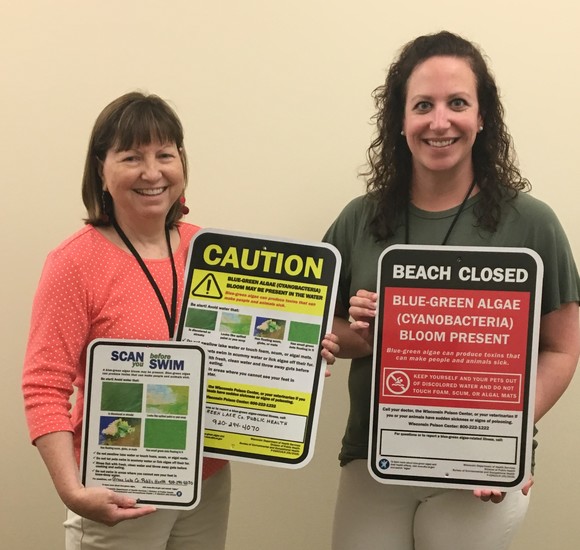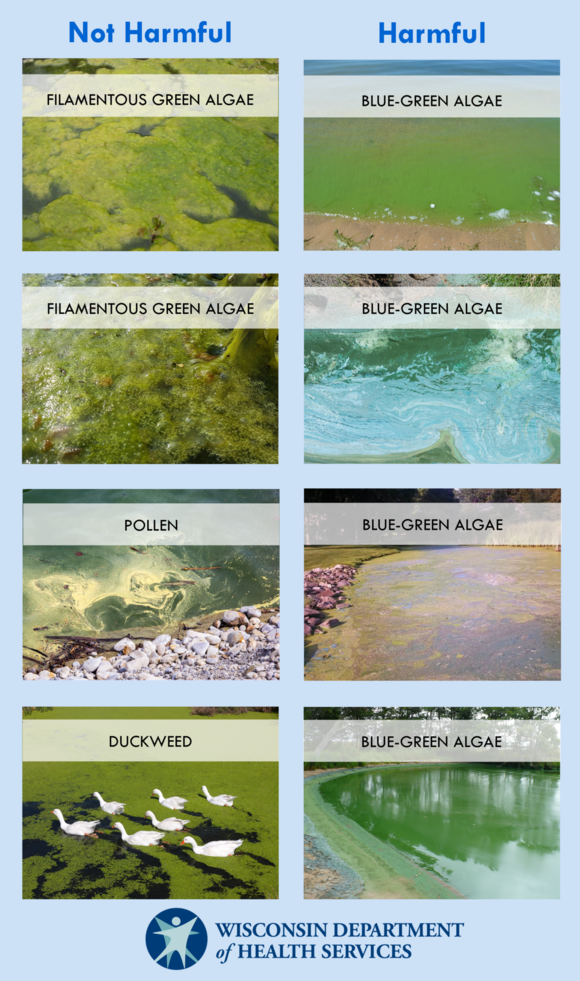
A long overdue "hello" from the Division of Public Health Harmful Algal Blooms
Program!
Did 2020 really happen? It sure did, and folks seem to be making up for lost time now more than ever. With people spending more time outdoors with their friends, families, and pets this summer, reports of human and animal illnesses potentially related to blue-green algae exposure have already been submitted to our Division of Public Health Harmful Algal Blooms (DPH HAB) Program.
With recent high humidity and soaring temperatures, your jurisdiction may have already received reports of blooms, and more may be on the horizon. The DPH HAB Program wants to help you prepare for effective messaging to the public about HABs and water safety, as well as provide you with the resources you’ll need to address blooms and related illnesses. Below you'll find a compilation of FAQs, quick links, sample social media posts, and other resources to help you prepare for the 2021 HABs season. Be sure to save this guide for quick future reference!
FAQs
What if I receive a report of a blue-green algae bloom?
If you receive a report of a bloom without an accompanying illness, report the bloom to the Wisconsin Department of Natural Resources (DNR). Include descriptions of bloom size, duration, and location with lake, town, and county name, and photos taken both close-up and farther away. The DNR is unable to sample and test in response to each bloom report, but may be able to confirm whether cyanobacteria are present from submitted photos. Please note that this email address is monitored during normal business hours, so responses to reports received outside business hours may be delayed.
What if I receive a report of a human illness suspected of being related to blue-green algae?
Blue-green algae (cyanobacteria) and cyanotoxin poisoning is now a Category II reportable condition in Wisconsin. Cases must be reported to the local public health department of the jurisdiction where the ill person resides within 72 hours of case recognition. Local health departments should report the suspect case to WEDSS as soon as possible and reference the Case Reporting and Investigation Protocol for guidance. Due to the complexity of case investigation and risk assessment, the DPH HAB Program will work with local health and tribal agencies on case investigations. The HAB Program has been investigating suspect cases of HAB-related illness for over 10 years and will continue to offer technical assistance, including possible water sampling, to local health and tribal agencies during case investigations.
What if I receive a report of an animal illness suspected of being related to blue-green algae?
Report the suspect case to the DPH HAB Program. The HAB Program will work with the local health agency to investigate the illness. Suspected blue-green algae-related illnesses in animals are important to report because they may serve as sentinels for human illness.
Who has the authority to close a public beach or swim area due to a human health hazard (e.g., blue-green algae), and when can they do it?
Per Wis. Stat. § 254.46, “the... local health department shall close or restrict swimming, diving, and recreational bathing if a human health hazard exists in any area used for these purposes on a body of water and on associated land and shall require posting of the area." Local health departments and tribal agencies have primary authority for issuing health advisories, beach or water body closures, and public messaging. An exception exists for state parks and state forests; at many of these locations, the DNR will post signage and close public beaches.
Local health and tribal authorities can issue a health advisory and close a public beach due to blue-green algae when testing or visual observation suggests a high probability of adverse human health effects (>100,000 cells/mL cyanobacterial cell density, elevated cyanotoxin concentrations, or a visible cyanobacteria scum layer is present).
When can a beach be reopened?
Reopening a swim beach can depend upon follow-up test results, visual inspection of the water quality, and allowing time for cyanobacteria and cyanotoxin levels to drop. If your jurisdiction is interested in developing or readjusting a monitoring program for HABs, please visit the Environmental Protection Agency's Recommendations for Cyanobacteria and Cyanotoxin Monitoring in Recreational Waters.
Quick links
Signage
Did you know that the DPH HAB Program offers signage? Signs are available in PDF and aluminum metal formats. Please email the HAB Program for prototypes, pricing, and more!
 Four designs are available, including: “Scan Before You Swim,” "Caution," “Beach Closed,” and “Is it Blue-Green Algae…Or Something Else?” The last design illustrates common blue-green algae bloom conditions in Wisconsin as well as non-harmful water conditions often confused with blooms.
 Green Lake County health officer Kathy Munsey (left), and public health nurse Rachel Prellwitz (right), show off new blue-green algae beach signs. Metal signs are made of high quality aluminum and are offered in 9”x12” and 12”x18” sizes. Metal 6.5’ stakes are also available for purchase.
 |
|
Meet Jordan Murray
Jordan Murray is our new Wisconsin Water Resources Science-Policy Fellow. She will focus on leading our state’s public health response to cyanobacterial HABs as well as a number of outreach efforts in this area.
Jordan earned a Master’s in Public Health-Epidemiology from the University of Toledo and a B.A. in Neuroscience from the College of Wooster. She comes to us with valuable experience leading a handful of HAB-related research and outreach projects, both as a graduate assistant and at the Great Lakes Commission as a project lead. Many of her recent projects have dealt with major topics of interest in the HAB arena, such as the chronic long-term effects of HAB toxins and the health effects associated with aerosolized toxins. She has also led a data project utilizing a national longitudinal hospital database to determine associations between HAB diagnoses and geographical and demographical populations in the United States.
As a Toledo, Ohio native (home to the 2014 HAB toxin drinking water crisis), HABs are also a personal matter to her.
Throughout her fellowship, she will provide public education about HABs and work closely with local public health and the DNR to investigate related illnesses. You can reach her at DHSDPHHABS@dhs.wi.gov.
|
 |
|
Let's Get Social |
Suggested social media posts and accompanying photos:
Heading to the lake? Be on the lookout for blue-green algae! Keep your family—especially young children and pets—away from water with noticeable discoloration or surface scum, foam, and algal mats. Learn more: https://www.dhs.wisconsin.gov/publications/p01888.pdf
 If you’re bringing Fido to the beach, remember to be on the lookout for blue-green algae. Avoid stagnant water and areas with noticeable discoloration or surface scum, foam, and algal mats. Give your pup a rest from fetching and bring along fresh, clean water for him to drink. Learn more:
https://www.dhs.wisconsin.gov/publications/p0/p00089.pdf
 Did you know that blue-green algae blooms have look-alikes? Learn the difference and when in doubt, stay out! Learn more about blue-green algae:
https://www.dhs.wisconsin.gov/publications/p01888.pdf

 |
|
Missed a past issue? Previous issues are available on our Resources for Health Professionals webpage.
Email us your burning questions! If others can benefit from hearing the answer to your question, we’ll feature it in a future issue.
Remember that we are always available for consultation on any HAB health-related issue by email or phone (608-266-1120).
|
|